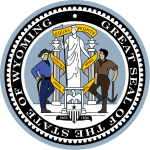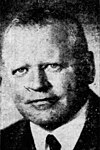
The 1982 Wyoming gubernatorial election took place on November 2, 1982. Incumbent Democratic Governor Edgar Herschler ran for re-election to a third term. He faced former State House Speaker Warren A. Morton in the general election after several prominent Republicans, including then-Congressman Dick Cheney, declined to challenge him. However, Herschler remained personally popular and the national political environment favored Democrats, and he had little difficulty defeating Morton to win a third term. In doing so, Herschler became the first Governor of Wyoming to win three terms in office.

The 1954 Wyoming gubernatorial election took place on November 2, 1954. Incumbent Republican Governor Clifford Joy Rogers ran for a full term as Governor of Wyoming after Frank A. Barrett was elected to the U.S. Senate, but lost the nomination to former State Representative Milward Simpson. Simpson narrowly defeated Democratic former Secretary of State William Jack in the general election.

The 1942 Wyoming gubernatorial election took place on November 3, 1942. Incumbent Republican Governor Nels H. Smith ran for a second term as governor. After defeating several opponents in the Republican primary, he advanced to the general election, where he was opposed by Lester C. Hunt, the Wyoming Secretary of State and the Democratic nominee. In a reversal from Smith's landslide election in 1938, Hunt narrowly defeated him in his attempt at a second term.

The 1918 Wyoming gubernatorial election took place on November 5, 1918. Following the election of Governor John B. Kendrick to the U.S. Senate in 1916, Secretary of State Frank L. Houx served as acting Governor. He ran for re-election and faced a stiff challenge in the Democratic primary from attorney William B. Ross. After defeating Ross by a decisive margin, he faced Robert D. Carey, the Republican nominee and the son of former Democratic Governor Joseph M. Carey. However, despite Houx's past electoral success, he faced difficult headwinds as Democratic candidates did poorly across the country in 1918. He ended up losing re-election to Carey by a wide margin.

The 1934 Wyoming gubernatorial election took place on November 6, 1934. Incumbent Democratic Governor Leslie A. Miller ran for re-election to his second term, and his first full term, following his initial election in the 1932 special election. Miller faced Republican Alonzo M. Clark, his predecessor as governor, in the general election. Despite the closeness of Miller's first election, he took advantage of the nationwide Democratic landslide and easily defeated Clark.

The 1934 United States Senate elections in Wyoming took place on November 6, 1934. Incumbent Democratic Senator John B. Kendrick died on November 3, 1933, and Joseph C. O'Mahoney was appointed by Governor Leslie A. Miller as Kendrick's replacement. Two elections for the same Senate seat were held on the same day; one as a special election to fill the remainder of Kendrick's original six-year term, and another to select a Senator to serve the next six-year term. O'Mahoney ran for re-election in both elections. He was opposed by Republican Congressman Vincent Carter. Aided by the strong performance by the Democratic Party throughout the country in 1934, and by Governor Miller's landslide re-election, O'Mahoney handily defeated Carter to win re-election.

A general election was held in the U.S. state of Wyoming on Tuesday, November 2, 1926. All of the state's executive officers—the Governor, Secretary of State, Auditor, Treasurer, and Superintendent of Public Instruction—were up for election. Republicans narrowly picked up the governorship and solidified their control on the other statewide offices, increasing their margin of victory in each race.

A general election was held in the U.S. state of Wyoming on Tuesday, November 4, 1930. All of the state's executive officers—the Governor, Secretary of State, Auditor, Treasurer, and Superintendent of Public Instruction—were up for election. Republicans narrowly held onto the Governor's office and won every other state office.

A general election was held in the U.S. state of Wyoming on Tuesday, November 6, 1934. All of the state's executive officers—the Governor, Secretary of State, Auditor, Treasurer, and Superintendent of Public Instruction—were up for election. In the 1932 gubernatorial special election, the Democratic candidate, Leslie A. Miller, won and ran for re-election for a full term in 1934. The Democratic Party also won elections for Secretary of State, Auditor, Treasurer, and Superintendent of Public Instruction, flipping those offices from the Republican Party.

A general election was held in the U.S. state of Wyoming on Tuesday, November 3, 1942. All of the state's executive officers—the governor, secretary of state, auditor, treasurer, and superintendent of public instruction—were up for election. Like the 1938 elections, this year's elections were something of a mixed bag for both parties. Democratic secretary of state Lester C. Hunt successfully defeated Republican governor Nels H. Smith for re-election, but Republicans flipped the secretary of state's office in Hunt's absence. The other incumbents—State Auditor William M. Jack, a Democrat, and Superintendent Esther L. Anderson, a Republican—were re-elected, and Republicans held onto the state treasurer's office.

A general election was held in the U.S. state of Wyoming on Tuesday, November 5, 1946. All of the state's executive officers—the governor, secretary of state, auditor, treasurer, and superintendent of public instruction—were up for election. The election was largely a rout for the Republican Party. Though Democratic governor Lester C. Hunt was narrowly re-elected, Democrats lost their two other state offices: auditor and secretary of State. Moreover, they were unable to win back any other state offices.

A general election was held in the U.S. state of Wyoming on Tuesday, November 4, 1958. All of the state's executive officers—the Governor, Secretary of State, Auditor, Treasurer, and Superintendent of Public Instruction—were up for election. Democrats had a largely good year, picking up the Governorship and the Secretary of State's office and holding the State Superintendent's office, though Republicans were returned as State Auditor and State Treasurer.

A general election was held in the U.S. state of Wyoming on Tuesday, November 8, 1966. All of the state's executive officers—the Governor, Secretary of State, Auditor, Treasurer, and Superintendent of Public Instruction—were up for election. After winning all of the statewide executive offices in 1962, Republicans did even better in 1966, improving their margins of victory in each race and holding all the offices.

A general election was held in the U.S. state of Wyoming on Tuesday, November 3, 1970. All of the state's executive officers—the Governor, Secretary of State, Auditor, Treasurer, and Superintendent of Public Instruction—were up for election. Continuing their success from 1962 and 1966, Republicans won all of the statewide executive offices once again, and all of them by large margins.

A general election was held in the U.S. state of Wyoming on Tuesday, November 5, 1974. All of the state's executive officers—the Governor, Secretary of State, Auditor, Treasurer, and Superintendent of Public Instruction—were up for election. Democratic gubernatorial nominee Edgar Herschler won a sizable victory in the gubernatorial election, and while Democrats generally improved their margins in the other statewide races, they fell short in all four.

A general election was held in the U.S. state of Wyoming on Tuesday, November 2, 1982. All of the state's executive officers—the governor, secretary of state, auditor, treasurer, and superintendent of public instruction—were up for election. Democratic governor Edgar Herschler won a landslide victory on his way to a record third term in office and Democrat Lynn Simons, first elected in 1978 as superintendent of public instruction, won a sizable re-election as well. Republicans held the other statewide offices.

A general election was held in the U.S. state of Wyoming on Tuesday, November 4, 1986. All of the state's executive officers—the Governor, Secretary of State, Auditor, Treasurer, and Superintendent of Public Instruction—were up for election. Democrats performed well in the year's elections; Democratic nominee Mike Sullivan won the gubernatorial election by a decisive margin, Superintendent Lynn Simons won a sizable majority in her bid for a third term, and Kathy Karpan won the open Secretary of State's race. Republicans prevailed in elections for State Auditor and Treasurer.

A general election was held in the U.S. state of Wyoming on Tuesday, November 6, 1990. All of the state's executive officers—the Governor, Secretary of State, Auditor, Treasurer, and Superintendent of Public Instruction—were up for election. Democrats Mike Sullivan and Kathy Karpan were re-elected as Governor and Secretary of State by landslide margins, while Democrat Lynn Simons was defeated for re-election by Republican Diana Ohman. Republicans also continued their winning streak in the elections for State Auditor and State Treasurer.

A general election was held in the U.S. state of Wyoming on Tuesday, November 7, 1922. All of the state's executive officers—the Governor, Secretary of State, Auditor, Treasurer, and Superintendent of Public Instruction—were up for election. Democrats improved considerably from their performances in 1918, with William B. Ross winning the gubernatorial election and almost all of their statewide candidates outpacing their 1918 nominees. However, Republicans held all of the other statewide offices.

A general election was held in the U.S. state of Wyoming on Tuesday, November 3, 1914. All of the state's executive officers—the Governor, Secretary of State, Auditor, Treasurer, and Superintendent of Public Instruction—were up for election. Governor Joseph M. Carey declined to seek re-election to a second term, and Democratic State Senator John B. Kendrick was elected as his successor. Republicans, however, won all of the other statewide executive offices, including picking up the Superintendent's office.










